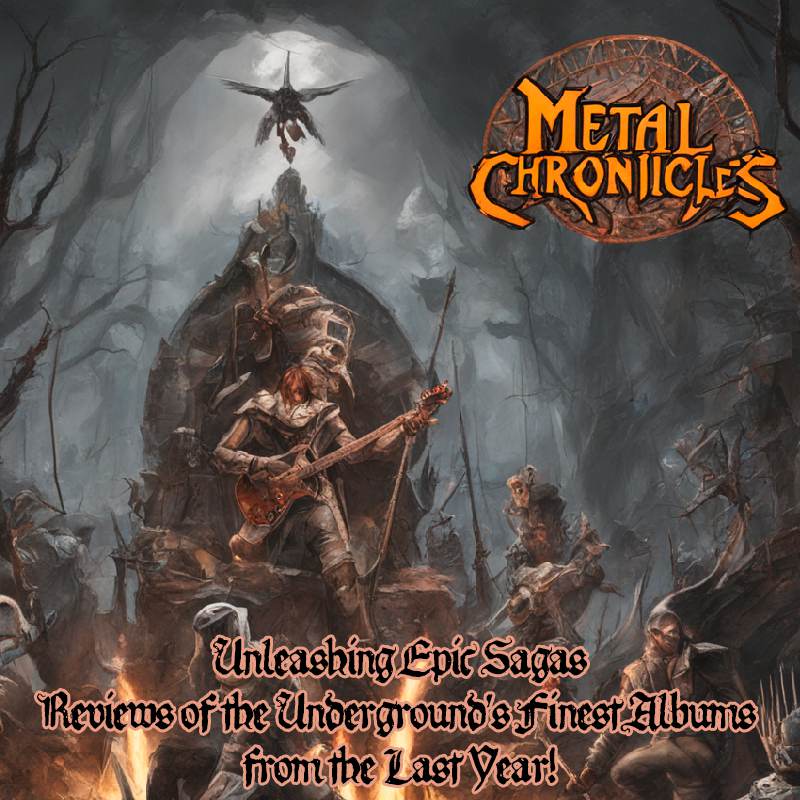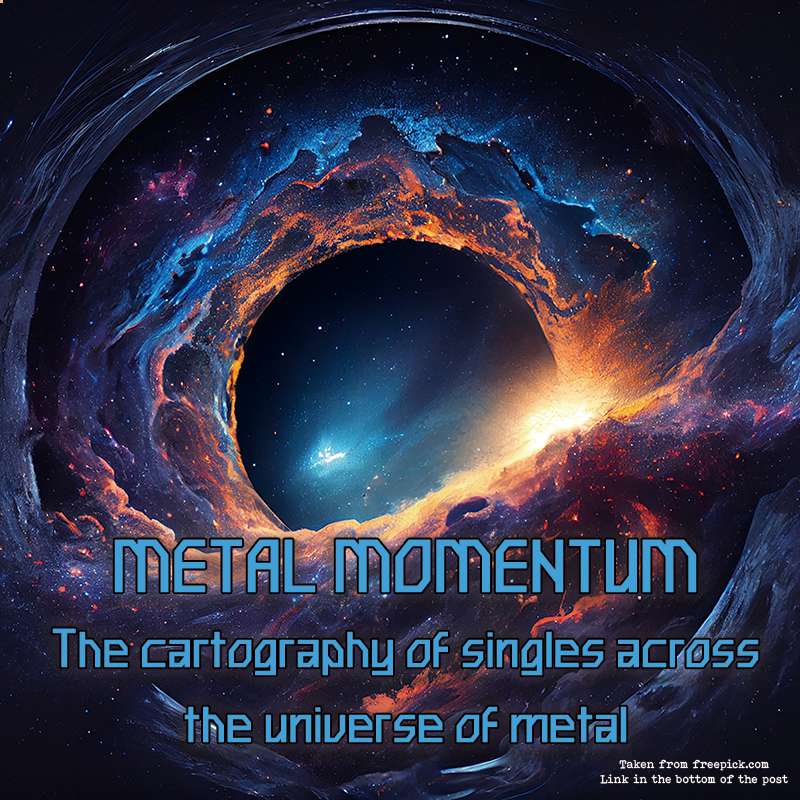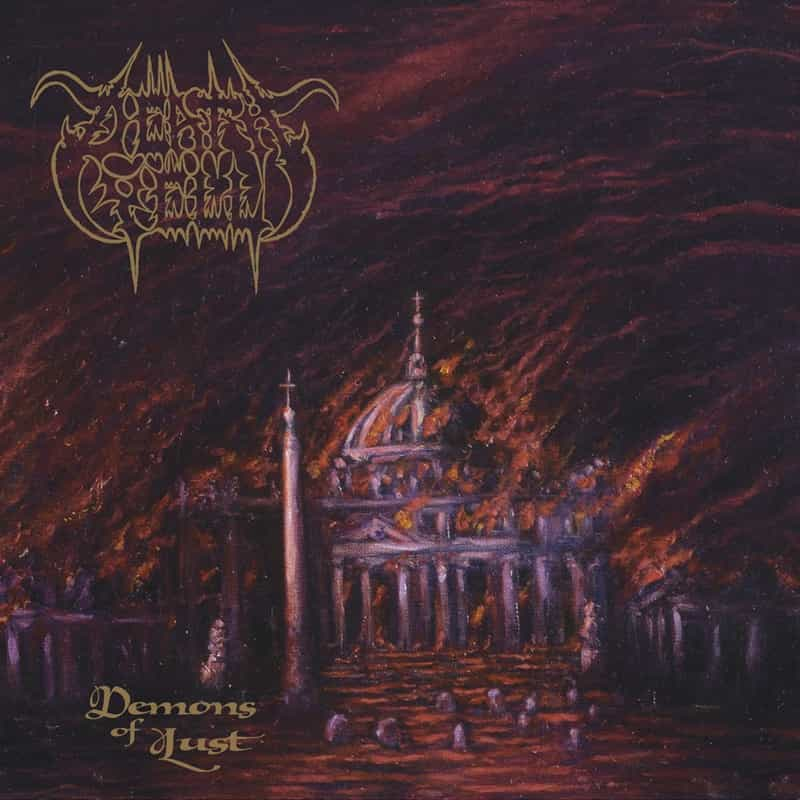#UniversalTheory Collapse


Band: Universal Theory
Title: Collapse
Label: Metal Hell Records
Release date: 03 March 2023
Country: Spain
Format reviewed: High-quality Digital Recording
Universal Theory – Collapse
A Gothic Metal Odyssey through Nostalgia and Rebellion”
“Join me for a Spanish goth metal experience that transcends genre preferences with Universal Theory, a duo highly recommended among enthusiasts. Gothic metal with a sound that brings reminiscences of immortal bands like Lacrimosa, Candlemass, Ufomammut, Umbra et Imago and Type o’ Negative, join me to explore the depths of nostalgia and human emotions, to reflect on social and moral decadence, to challenge authoritarian systems of all kinds, to question the status quo, the official version and to navigate the game of life while maintaining firm hope for a better tomorrow, hand in hand with a diverse and attractive sound experience” (Elyna Steel)
I confess I am not particularly into goth metal; mine is about dragons, swords, princesses, castles, warriors, shires, and rainbows, mainly, but the work of this Spanish duet is worth listening to and highly recommended among goth people.
The album’s first track, “The Colors of the Night I” lasts 04:46′ and begins “throwing all the meat on the grill,” as we say in my country. It features goth keyboards, catchy riffs, and a rhythm that invites dance to metal. Yes, dancing to metal is one of the best things about the goth metal subgenre, totally dispelling the stereotype that metal merely sounds like screaming. But no, it’s also dancing!
The first verses reveal the band’s influences such as Lacrimosa and Umbra et Imago. The deep voice of Jesús Pinilla in the first verses and that of Maria Jose Martos in the chorus provide a sensually romantic atmosphere, making me remember the legendary Wolf/Nurmi duet. The meter establishes a rhythmic pattern that guides the listener through the music, creating a sense of stability and structure. Meanwhile, the vocal colors and dynamics add depth and nuance to the lyrics. Together, these elements enhance the lyrical content and make the song more engaging for the audience, making it very catchy and easy to follow, without great embellishments or displays of bombast. In my opinion, it has just what is necessary to be a more than suitable song to use in any goth party playlist, ensuring success.
The story behind the lyrics is about reflection, a celebration of the human experience and life transitions, symbolized by the mention of traffic lights and changing colors, and how these give different atmospheres to the streets of a city. The reference to a car that travels in time reminds me of another one- through experiences and memories. Old memories create current feelings, leading us to an inner space where the past shapes our present. It invites us to dig into the complexity of our minds to be able to live in the present moment, celebrating life, love, and relationships. The calling is to enjoy the energy of the night, jumping, loving, singing, dancing, and feeling. Excelent track!
The second track is titled “Based on True Events” and has a duration of 03:13. This song delves into a myriad of thought-provoking themes, exposing the “true events” that unravel in its lyrics, such as wars, brutality, crimes, mass manipulation through deceit, depicting endless suffering. There’s a crucial message that applies to every one of us: embrace critical thinking, refrain from blindly accepting the “official narrative,” and instead pursue the truth independently. Safeguard your freedom of thought, master the art of reading between the lines, and fortify yourself against any attempts to deceive or exploit you.
The performance starts with a depiction of “war sounds”: shotguns, exploding bombs, helicopters, and the continuous rattling of machine guns, establishing a dynamic atmosphere of conflict. The music then transitions into dense, powerful riffs with a mid-tempo style reminiscent of bands such as “My Dying Bride”, “Candlemass” and “Ufomammut”. The section bridging the intro and the first verse is slightly short but maintains a musical flow between the two segments and contributes to the overall cohesion of the song and its musical pattern without significant variations.
In terms of vocals, Jesus sings alone, delivering a sober performance in his mid-low vocal range, expressing emotions like anger, despair, and protest without resorting to excessive vocal embellishments.
Track 3, “Distant Times” runs at 04:30 and is an ode to nostalgia, the complexity of memories and the search for transcendence in life. Yesterday’s memories and experiences transform our present times, so there is a try to give significance to life. The lyrics promote a sense of longing for yesterday’s good things, reflections of oneself, and a wish to progress, but not change everything. It describes being caught up in remembrances and past events that are still haunting while trying to find a way out of this maze or something meaningful in life today.

The track is a pure doom piece with a steady slow tempo. It kicks off with a dense, serious riff that sets a rhythmic and melodic base in a 4/4 time signatura and slow tempo. The intro combines acoustic keyboard and guitar, reminiscent of the mood found in the first verse of Nightwish’s “The Carpenter,” sung by Tuomas Holopainen, albeit with a deeper vocal tone.
As the song progresses, the chorus adopts riffs akin to Anathema’s style—simple yet catchy, making it a pleasant listen. Post the second chorus, there’s an electronic keyboard section blending seamlessly with heavy bass riffs, coupled with a slight drum acceleration. The bridge stands out with intensely, amazing guttural vocals that give you goosebumps and produce a sensation of intense heat in the middle of your chest, evoking a nostalgic and poignant atmosphere. The final chorus retains its essence without major alterations. The song concludes abruptly at the end of the chorus, leaving a lasting impact. Overall, it’s a very well-done piece, weaving together various elements to create an emotive musical journey.
Track 4 is “The Color of the Night II” and has a duration of 04:18. The song is an invitation to enjoy the magic of the night including its colors, shines and mysteries, conveying a feeling of freedom and disinhibition. I appreciate the hard work put into this song and appreciate its potential. However, I consider a little refinement could provide a more enriching listening experience.
The intro feels bare; exploring different effects, such as brighter, denser, or deeper tones, could improve the overall vibe. The mastering gives off a raw quality that contrasts with María Jose’s voice. I think a more balanced mastering approach could allow her voice to shine to its full potential. Also, some phrases seem a little delayed at times. With more successful mastering and phrasing in the right tempo, the overall impact could be higher. I also noticed that certain vocal nuances are weak and inaccurate, but I understand that perfection takes time. There is room for improvement in this aspect. I’ve taken note that within the starting verses, the guitar arpeggios tend to overshadow the voice rather than complement it. This could be contributing to a few of the vocal shortcomings. I felt a certain “challenge” between the voice and guitars that, unfortunately, did not contribute to the general composition enhancement. Also, it may be beneficial to review future mix processes to achieve a better balance such as that established in the choruses where the melody forms an atmospheric backdrop, allowing the vocals to stage properly. Track with major improvement potential.
“Remember” track number 5, spanning 05:53 unveils a unique sonic landscape. It kicks off with dense, long-bar riffs at a slow tempo of around 55 bpm, a distinctive feature in my opinion. As the composition unfolds, electric guitar arpeggios, laden with minor notes, make their entrance. An Anathema-style atmospheric keyboard then adds a gloomy, sad, and hopeless ambiance to the initial verses, beautifully sung by Jesus. This evocative structure repeats through subsequent verses.
The chorus takes a compelling turn as it transforms into a duet, with Jesus lending his voice in his lowest register. María José, in true Lacrimosa style, shines during the choruses, contributing to the melancholic atmosphere, though she takes no part in the verses. Thematically, the song delves into the sorrow of parting from a loved one who is still cherished and profoundly missed. There’s a poignant and somber ambiance, closely mirroring the emotions associated with death, as conveyed through the poignant interpretations of Jesus and María José.
The composition immerses the listener in funeral doom at its most splendid, evoking a range of emotions including depression, sadness, nostalgia, loneliness, and an overarching sense of cold. The song becomes a poignant expression of grief over the separation from a beloved individual who continues to be loved and deeply missed.
“Wickedness” is track 6 and runs for 06:08. Here we dive deep into the themes of societal and moral decay, going into the profound emotional impact on our minds and souls. The lyrics show a vivid and raw depiction of the human experience, exploring the depths of despair, tragedy and suffering. Helplessly, we witness how those in positions of power, such as politicians and religious leaders, blatantly deceive and manipulate the innocent. The narrative sheds light on the heartbreaking reality of these dark dimensions of our existence.
Musically speaking, the track is quite intriguing. The introduction comprises an atmospheric interplay of rhythmic, melodic keyboards and powerful riffs. The tempo oscillates between a lively Vivace during the intro and verses, and a Moderato during the choruses and bridge, adding a dynamic layer to the composition. The vocals, delivered solely by Jesus, present a deep voice in the verses while shifting to a middle range in the choruses and bridge, creating a reminiscent of the iconic Lacrimosa style. The bridge is particularly interesting, it presents various musical elements, launching with an electrifying mix of pulsating techno-industrial keyboards and catchy melodic riffs at an Allegro pace. As the piece progresses, the tempo shifts to a smooth Andante, introducing an accurate doom-metal instrumental section in a steady 4/4 time. The energy picks back up with a return to the allegro tempo, featuring a catchy keyboard solo with a techno flair. The climax of the journey is reached as the adagio tempo sets in, enveloping you in an epic doom metal performance. This dynamic evolution showcases an interesting fusion of diverse tempos and styles, delivering a intriguing and pleasant auditory experience. Excelent track.
The song “Collapse,” named after the album and positioned as track 7, runs for 05:07. Its lyrics delve into life’s ongoing challenges, addressing themes like pain, anger, internal conflicts, and societal issues. Notably, the song explores the delicate interplay between hope and despair. A key element of the song is its explicit reference to the elite, depicting them as architects of social collapse. The lyrics use a metaphorical chess game, portraying the elite strategically manipulating society, with the rest of the population acting as unwitting pawns following their directives. The concept of the “engineering of hate” is introduced as a synonym for social engineering, where societies are molded by the ruling class to create, promote, and destroy ideologies. These ideologies function as parasitic implants in people’s minds, encompassing elements like religion, political parties, and divisive factors, all perpetuated under the mantra of “divide and rule.” The depth of these lyrics encourages reflection and contemplation.

The meter of the song is diverse and interesting, being a relevant aspect of the track. In the verses, the vocals have the potential to improve, but in the chorus they are precise. There is an opportunity to get more out of the vocal range, especially by adding vocal embellishments. The song follows a ¾ time signature and an andante-type tempo in the verses and first choruses. The bridge, marked by an electronic keyboard, introduces a change in the following measures, which become 4/4 with a walking tempo. María José enters the scene after the bridge, in a 4/4 section with an andante tempo. Vocally, he could shine even more by experimenting with the lower notes of his register, possibly incorporating two-part vocal harmonies.
The guitar riffs, the rhythm section, together with the deep voice of Jesús, which sometimes has a slight delay effect, and the high voice of María José in the treble, create a beautiful nostalgic atmosphere in the composition. It would be exciting to see María José daring with harmonies using her lower register. I am positive the result would be wonderful!
Track number 8 is “Hope” and runs at 03:10′. The lyrics of the song – I allow myself to speculate – make direct reference to the church as a plenipotentiary authority that writes “sacred lines” without questioning. The song suggests that the church’s attempts to impose a singular way of faith and thought are flawed, as the lies and inconsistencies in its teachings are evident to many. It also touches on powerful figures in society who use their influence to control minds and prevent any revolutionary ideas that might threaten their dominance. The song encourages listeners to fight against these oppressive systems with love, urging them not to blindly accept imposed beliefs and biased perspectives, but to question, criticize and reject all forms of dogma.
The song has a 4/4 adagio structure. It starts with Jesus’ harmonized vocals and keyboards, gradually building up to an intense instrumental section. The verses have deep vocals and a subtle guitar distortion, reminiscent of bands like Opeth and Anathema, with low-register vocals. The bridge is expansive and lively, leading into the final sections with the return of the low guitar distortion, followed by powerful riffs and a sweet melody in the style of a rock lullaby, ending with a doom metal essence that stops abruptly. Despite being shorter than other compositions, it’s a calming piece that’s nice to listen to.
Track 9, “Everyone of you” has a duration of 04:50. Is a desperate call for attention, a message about the impact of our actions on the world. Earth is suffering because of the consequences of uncontrolled growth and limited creativity, which lead to desperation and desolation. But hope is still within each of us, we have the potential for positive change, making a difference. Powerful message about responsibility, hope, and the need to take positive action to protect the planet.
The composition is in 4/4 compass, slow tempo. Starts as the preceding piece, with Jesus singing solely in the verses from the second, adding dreamy keyboard and laid-back guitar chords with no major effects along the track. In the middle, Maria Jose speaks in a style synonymous with breaking news reports or forecasts, followed by a stream of drum rolls and faster string attacks in riffs, The end of the song sees a nostalgic and emotional performance from Jesus singing softly, much like how the track starts. It’s a lovely piece, one of the most relaxed from the álbum.
“Permanent Regression”, the tenth and final song lasts 04; 08’ and recalls the structure of some Type O’ Negative songs but at a slower pace in the first half, dominated by faint chords without distorted guitar notes that adhere to a standard soft gothic metal 4 /4. structure. The second half of the song contrasts with different styles: doom, dance, gothic and even power metal at the end. María José then appears on stage singing beautifully in her highest vocal range. The song ends with a delicious growl from Jesus, with a very dense melody and an abrupt ending. This track is really interesting and diversified, among my favorites on the album.
The themes explored in this track convey a sense of nostalgia and introspection, expressing a yearning to revisit a previous state of being or a specific moment in time. The use of imagery related to the past evokes a longing for something lost or a desire to reconnect ith a former self. Additionally, the track delves into the relationship between time and the mind, suggesting a contemplation of how the passage of time impacts personal identity and consciousness. I can relate these themes to the experience of individuals with Alzheimer’s, who live in a state of permanent regression, losing valuable memories that once defined their identity. This loss of remembrance is akin to being robbed by the thief of memory. Undoubtedly, these emotional lyrics invite deep reflection.
Overall, “Collapse” offers a diverse listening experience in terms of music styles, its lyrics are deep and invite thoughtful reflection. The obstacle refers to the sound achieved in the mastering of the album, which added to some vocal aspects that undoubtedly have a whole spectrum of potential to improve in future productions, makes me rate this production 6/10: Elyna
Band
Bandcamp
Facebook
Instagram
Spotify
Twitter
YouTube
Deezer
Label
Bandcamp
Twitter
YouTube
Instagram
Facebook
6/10 We may survive!
**Please support the underground! It’s vital to the future of our genre**
#WeAreBlessedAltarZine
#TheZineSupportingTheUnderground


